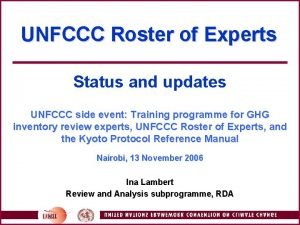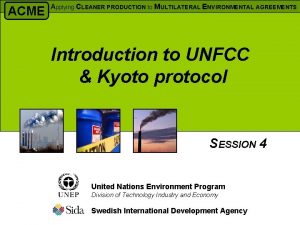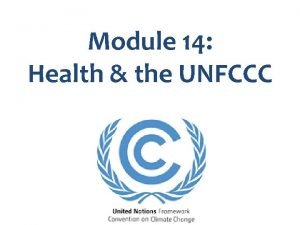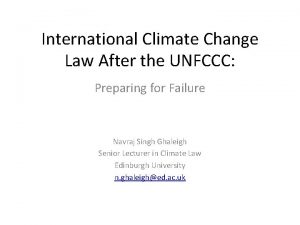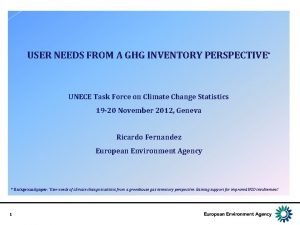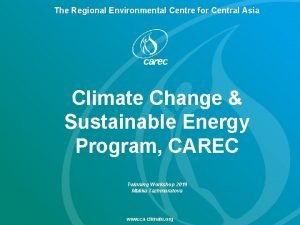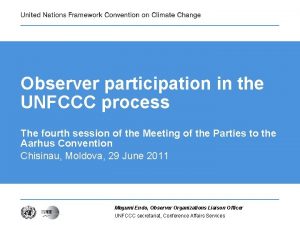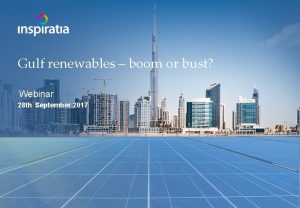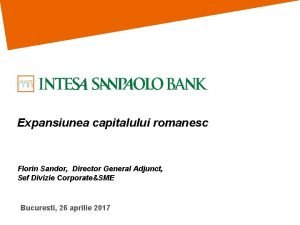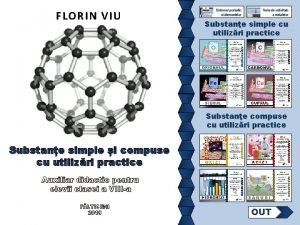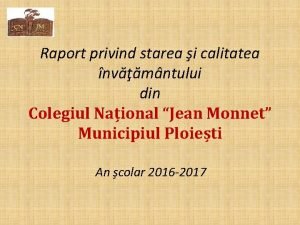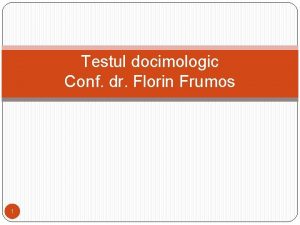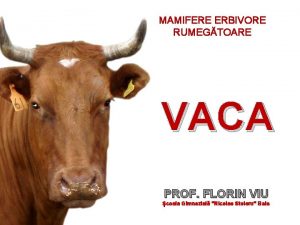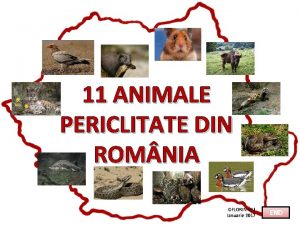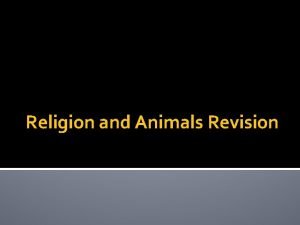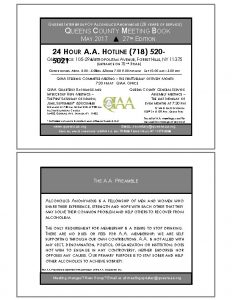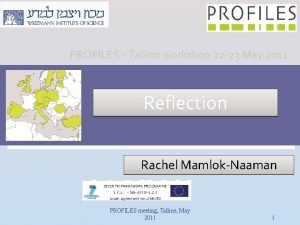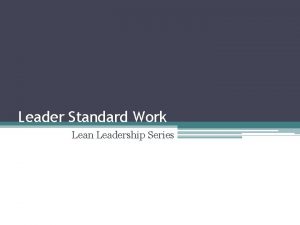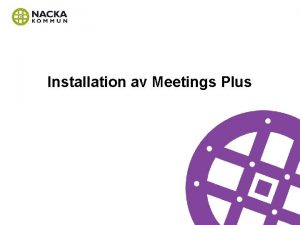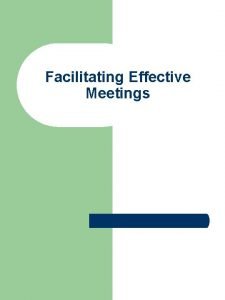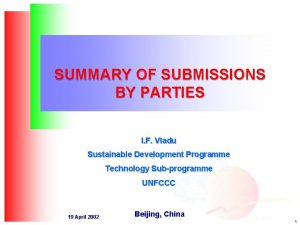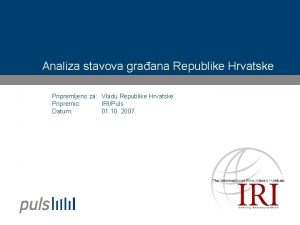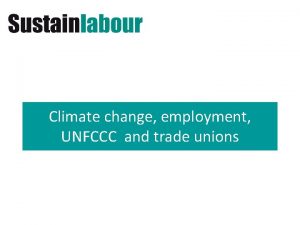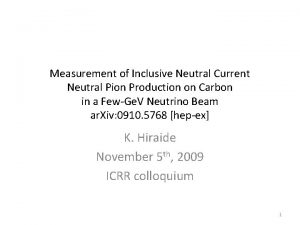CLIMATE NEUTRAL UNFCCC MEETINGS Iulian Florin Vladu and








































- Slides: 40

CLIMATE NEUTRAL UNFCCC MEETINGS Iulian Florin Vladu and John Henssen UNFCCC Secretariat May 2005 Bonn, Germany 1

OBJECTIVE o The objective of this initiative is to ”neutralize” the emissions of greenhouse gases (GHG) associated with conducting sessions of the Conference of the Parties and subsidiary bodies through climate change mitigation measures elsewhere Technology Subprogramme 2

BACKGROUND o At COP 9, the Kyoto Club, an Italian non governmental organization (NGO), volunteered to estimate and offset the GHG emissions of the session. The estimated 8, 000 tonnes of CO 2 equivalent were offset by emissions credits for two years of operation of a biomass-fired boiler for district heating in Hungary o In 2004 the secretariat started to work on making COP and SB sessions climate neutral. The Government of the Netherlands provided support for this initiative Technology Subprogramme 3

BACKGROUND o At COP 10, the secretariat organized a side event to discuss an initiative to make the subsidiary body and COP sessions climate neutral, to present estimates of the GHG emissions associated with the COP 10, and to share experiences and exchange views with Parties and other stakeholders on methodological aspects and options for offsetting these emissions o To further advance this initiative, the secretariat has prepared the document FCCC/SBI/2005/9 to seek views and get guidance form of Parties on this issue Technology Subprogramme 4

APPROACH (I) o Step 3 - Communicating, exchanging views and cooperating with relevant actors on this initiative Technology Subprogramme 5

APPROACH (II) o The guiding principle for implementing this initiative is to keep it simple, in order to reduce transaction costs o Therefore, REDUCING, which is an important step between step 1 (MONITORING) and step 2 (OFFSETTING) is not considered in the document o Ways and means to induce behavioural changes of the participants to UNFCCC meetings, selection of the venue based on “green” considerations, and “green” travelling of the participants, are not addressed, but, if needed, could be dealt with in future Technology Subprogramme 6

STEP 1 - FIND OUT HOW MUCH (MONITORING) o Identify and review methodologies for calculation of greenhouse gas emissions associated to hosting meetings o Select/develop a methodology and perform an initial calculation of the emissions associated with hosting COP 10/SB 21 and SB 22 to get a better understanding of the order of magnitude of these emissions and the significance of different type of activities that may be considered o Compare results with other methodologies and validate the methodology. Calculate the emissions associated with hosting COP 11 Technology Subprogramme 7

IDENTIFY AND REVIEW METHODOLOGIES o Existing methodologies take into account carbon emissions from: Ø Ø Travel of participants (air, train, car) Energy consumed waste generated at the conference venue Hotel accommodation and local transportation Pre and post activities of the organizers Example: Renewables 2004 (1. 4 tones ghg/participant) o Travel by air is the main contributor!!! Technology Subprogramme 8

AIR TRAVEL TOP-DOWN METHODOLOGIES (I) o Top-down methodologies: use average emission factors and clusters the flights in groups based on the flight distance (e. g. , short, medium and long haul) Ø Ø Ø WRI: short < 450; medium < 1, 600; long > 1, 600 km Renewable 2004: <1, 000; > 1, 000 km Atmosfair: < 250; < 500; < 750; < 1, 000; > 1, 000 km Technology Subprogramme 9

AIR TRAVEL TOP-DOWN METHODOLOGIES (II) o CO 2 emissions arising from air flights are calculated using publicly available information (e. g. , British Airways) Ø CO 2 emissions were estimated as 200 grams of CO 2 per passenger mile. Direct CO 2 emissions per passenger for a particular air flight is calculated as the total distance flown for that air flight (in miles) multiplied by CO 2 emissions per passenger mile Ø A more conservative approach is to calculate emissions per revenue passenger miles because it means that emissions from empty seats and non fare-paying passengers are incorporated in the calculation Ø Most passenger aircraft also carry cargo (not associated with the passengers) and, emissions per passenger should be reduced to reflect this. This impact of cargo varies by aircraft type and route, and for the purpose of this calculation, a figure of 15% is used Information Amount Source Revenue passenger kilometres for the 12 months ending 31 March 2001 119, 135 million passenger kilometres British Airways traffic statistics (Historic Data) http: //www. bashares. com/content/traffic. shtml British Airways CO 2 emissions in year ending 31 March 2001 17, 131, 000 t. CO 2 eq Social and Environmental Report 2001 (page 35). http: //www. britishairways. com/responsibility/ Adjustment factor for cargo 15% Estimate Technology Subprogramme 10

AIR TRAVEL BOTTOM-UP METHODOLOGIES (I) o Bottom-up methodologies: uses different emission factors based on: “real” types of planes; occupation of flights; flight altitudes; and stopovers Source: Atmosfair Technology Subprogramme 11

AIR TRAVEL BOTTOM-UP METHODOLOGIES (II) Determine flight route o o o Determine aircraft model Determine average utilization of aircraft Determine fuel consumption Calculate emissions Assess emissions Flight route: identify airports (start and termination of the flight, consideration of stopovers) and distance between airports Aircraft model: type and version (e. g. , B-747 -100/400), engine version, number of seats Average utilization of aircrafts: intercontinental - 80%, continental – 60% Fuel consumption: depends on the flight distance and phase (taxi, take-off, climb, cruise, descent, landing) Calculate emissions: 3. 155 kg CO 2 per kg kerosene Distance between the airport and the home/hotel/event venue should be considered in calculations Technology Subprogramme 12

AIR TRAVEL o Side by side comparison of tools for estimating emissions from air travels from Bonn to: Milan (COP 9); Buenos Aires (COP 10); and Montreal (COP 11) = 3 x or 3 x 1 solar collector in Eritrea for 27 months Notes: Atmosfair doesn't provide values for flight distances. For Milan the value was given because the model recommended to take a train. 500 ppm calculates a very high carbon emission for the travel to Buenos Aires The value of 1 ton of carbon differs significantly between models. In some cases over 50 per cent is associated with costs for running the web sites Technology Subprogramme 13

PROTOTYPE – CONCEPTUAL DIAGRAM UNFCCC secretariat (ICA) Notification + survey (8 weeks before the event) External databases (Internet) Airports (names, coordinates) distances, routes National Focal Points and/or Missions Electricity, heat, waste, local transportation Itineraries Host country data UNFCCC secretariat (AS + Prog. ) UNFCCC secretariat Delegates (2 weeks before the event) Registration Database Step 1 How much? Name and home/work - missing cities, address - spelling of towns names in English - no airport for some towns Calculation tool (default data) Carbon Neutral Database Nominated delegates Names, towns, airports Preliminary CO 2 emissions Prepare survey for participants (default data) Origin, destination, stopover(s) IMIS Database UNFCCC Secretariat activates the badge Survey forms Calculation tool (final data) Registration Mode, origin, destination, stopovers, # of days - Funded participants - Secretariat staff Revised airports, distances, routes Final CO 2 emissions Step 2 Offset Preliminary CO 2 emissions Technology Subprogramme 14

PROTOTYPE – ALGORITHM o Extract participants’ data (if participant's town exists then use it, otherwise use the town of his/her organization) o Find the airport for the participant's town (use distances, default airport, preferred airport) o Calculate the flight distance and decide the flight type (short-, medium -, long-haul). Calculate distances to and from airports o Repeat the above steps for all participants o Summarize the flight distances by type of flight and group of participants o Multiply the sums with the corresponding emission factors and sum the results Technology Subprogramme 15

PROTOTYPE – ALL PARTICIPANTS AT SB 22 o Get participants from the Registration database and group the participants by locations Technology Subprogramme 16

PROTOTYPE – DATABASES (II) o Constructed interfaces to import airports coordinates from the Great Circle Mapper web site Technology Subprogramme 17

PROTOTYPE DATABASES (III) o Established a database of airports and geographic coordinates of each airport (> 6, 200 entries) Technology Subprogramme 18

PROTOTYPE – CALCULATE TRALVE DISTANCES (I) o Algorithm to calculate the distance between the origin and destination of the flights Technology Subprogramme 19

PROTOTYPE – CALCULATE TRAVEL DISTANCES (II) o Some examples Reporting problems Selecting the default airport Technology Subprogramme 20

PROTOTYPE – GHG EMISSIONS FOR SB 22 o The value of total carbon emissions is strongly influenced by long haul flights and the IPCC radiative forcing index (RFI). A consequence of estimating emissions in this way is that the name “climate neutral” would be more appropriate to describe this initiative Technology Subprogramme 21

PRELIMINARY GHG EMISSIONS FOR SB 22 Notes: a Electricity and heating b Only hotel accommodation For a and b data from the conference centre and hotel Maritim in Bonn, UBA and UNFCCC Registry were used. Emission data from processing estimated 110 m 3 waste were not available Technology Subprogramme 22

PROTOTYPE – ALL PARTICIPANTS AT COP 10 o Parties and observer States make up only 35 per cent of the participants at COP sessions and about 60 per cent at subsidiary bodies sessions Technology Subprogramme 23

PROTOTYPE – PRELIMINARY GHG EMISSIONS FOR COP 10 o Only for 5, 700 participants registered by the end of first week (6, 197 final figure) o Includes the travels of UNFCCC staff? o Exclude emissions from delegations that are already offsetting them? Technology Subprogramme 24

FINAL GHG EMISSIONS FOR COP 10 a Estimated considering air travel to generate 98. 5 per cent of emissions from total transport and transport to generate 97. 5 per cent of total emissions Technology Subprogramme 25

REMARKS ON STEP 1 (I) o Review of methodologies: most of the existing tools are dealing with individual emissions. For large meetings such as Renewable 2004 and WSSD to calculate flying distances the participants were grouped by regions and significant errors were made in estimating their GHG travel emissions. The approach proposed is much more accurate o Final results cannot be obtained during COP/SB meetings Technology Subprogramme 26

REMARKS ON STEP 1 (II) o Some organizations and delegations are already offsetting their emissions. As these emissions are considered as part of the GHG emissions of the session they may be offset twice. Nevertheless, the identification of these cases and the assessment of the way the emissions are estimated and neutralized may become a resource intensive activity that may not be justified by the value of the emissions that are counted twice Technology Subprogramme 27

REMARKS ON STEP 1 (III) o The carbon footprint of COP and SB meetings is relatively small and can offset only a part of the emission reductions from one small- or medium-scale project. It is therefore possible to select the project before the final figure for emissions is available* o Should we consider COP and SBs meetings together or separately? (e. g, run calculations at SB and COP but offset at COP) o For COP meetings the secretariat is making bookings only for some 260 participants (including staff travel). Therefore, offsetting the emissions through a travel agent will not solve the problem for COP/SBs *CDM small-scale projects: non-energy – 15, 000 t. CO afforestration - 8, 000 t. CO 2 /year *CDM small-scale projects: non-energy – 15, 000 t. CO 2 (total emissions); afforestration Technology Subprogramme 28

REMARKS ON STEP 1 (IV) o Since the estimation tool was developed very small resources are needed to estimate the GHG emissions of a session o For example, for SB 22 one half day staff was needed to perform the preliminary estimations. One and a half day will be needed to finalize them Technology Subprogramme 29

STEP 2 - OFFSET EMISSIONS o Issues for offsetting o Estimate funds needed o Potential sources for funding o Options for offsetting activities o Previous experience on offsetting Technology Subprogramme 30

ISSUES FOR OFFSETTING Technology Subprogramme 31

ESTIMATE FUNDS NEEDED (I) o o Point carbon: - 8 February 2005, EUA 2005 (€/t. CO 2) € 7. 17 -0. 03 (23 May 2005 € 18. 59) WB: 3 -5 $/t. CO 2 for PCF; 5 -6 €/t. CO 2 for the Dutch fund o For CDM projects the carbon value is the result of a negotiation (unknown) o € 10 could be considered a reasonable planning value (half of the non-compliance costs) Technology Subprogramme 32

ESTIMATE FUNDS NEEDED (II) o A little more than EUR 180, 900 (using 7. 17 €/t. CO 2) would be required to neutralize COP 10 emissions o If COP 10 had been held in Bonn or in Montreal, the offsetting costs would have been EUR 79, 500 for Bonn and EUR 109, 800 for Montreal o For COP 10 the estimated voluntary contribution by each participant is an average of EUR 29, rather high and hence is not a preferred option for this initiative o Considering the above, it is recommended that the most of the funding for this initiative should be drawn from sponsors o If sponsorship will be accepted as a source of funding, criteria and the process for acceptance should be based on UNFCCC practice for working with sponsors and on United Nations guidelines on this matter Technology Subprogramme 33

POTENTIAL SOURCES FOR FUNDING (I) o Funding options for offsetting the carbon emissions associated with COP and SB sessions: Ø Contributions from sponsors (e. g. , private sector, foundations) Ø Contributions from delegations Ø Contributions from IGOs and NGOs Ø Contributions from the host country (COPs, SBs? ) Ø Contributions from Parties to the UNFCCC Ø Individual staff/delegates voluntary contributions Technology Subprogramme 34

POTENTIAL SOURCES FOR FUNDING (II) o WSSD experience: Ø Climate Legacy Certificates available for sale from $10 for individuals and from $1, 000, $10, 000 and $100, 000 in Bronze, Silver and Gold categories for corporations Ø 7 Government delegations, which have gone Carbon Neutral by committing a total of $80, 000 to the JCL. These are Austria, Canada, Monaco, Norway, Sweden, Switzerland, and the United Kingdom Ø 5 IGO delegations have gone Carbon Neutral contributing a total of $50, 000 including World Bank, UNDP, GEF, UNEP, and IUCN-The World Conservation Union Ø 31 corporations and business organizations including ICI, Shell, TEPCO and the Warehouse Group have contributed a total of $185, 000 Ø NGO’s have contributed $5, 000. This includes the support of the Heinrich Böhl Foundation Ø 1, 000 individuals have collectively made personal contributions totaling $7, 605 Technology Subprogramme 35

OPTIONS FOR OFFSETTING (I) o Several options exists such as purchasing emission credits from climate projects (CDM or non-CDM), from a carbon fund, or form an emission trading scheme o Regardless of the vehicle for offsetting, preference should be given to offsetting activities in developing country Parties to maximize the use of resources by creating ancillary social and economic benefits in these countries Technology Subprogramme 36

OPTIONS FOR OFFSETTING (II) o Renewables 2004: Ø Specific single project on solar-driven community kitchen in India Ø Gold Standard project Ø CER and CDM project development funded completely by Ministry of Environment Ø Project developer GTZ and Gadhia Solar, India o GTZ Ø Framework conditions for the offset project: » » » CDM project in the vicinity of GTZ activities Support in the project development (50 -70 % of costs) If possible SSP and Gold Standard Project type: renewables, energy efficiency or methane utilization ERPA with payment on delivery Internal development project (Env. manager; Ca. PP) Ø 3 projects for final selection in Algeria - wind power, India - hydro power, Thailand - methane recovery from waste water treatment in palm oil industry Technology Subprogramme 37

STEP 3 - COMMUNICATE RESULTS o An important activity, to be conducted in parallel with the two steps described above, is to communicate and exchange views with relevant actors on this initiative o A good communication strategy is a key element for the successful implementation of this initiative o The communication with Parties and potential contributors and sponsors was already initiated at the side event held at COP 10. On that occasion, the initiative was well received and the participants encouraged us to continue this work Technology Subprogramme 38

NEXT STEPS o o Views and guidance from Parties is needed… Some concerns expressed at the SBI plenary: Ø Will increase in the incremental costs to be supported by host countries. Would that change their willingness to host COPs? Ø Climate costs can be minimized as well as neutralized (meetings at a greater interval, in places that will result in lower emissions) Ø Will limit the participation of other groups than Parties and observers to reduce environmental costs after making so many efforts to promote inclusiveness in the Convention process Ø Can we really compensate for the CO 2 emitted through mitigation measures elsewhere? Technology Subprogramme 39

Thank you! Technology Subprogramme 40
 Drogurile si efectele lor
Drogurile si efectele lor Meetings, bloody meetings
Meetings, bloody meetings Discussion leader
Discussion leader Meetings bloody meetings 5 points
Meetings bloody meetings 5 points Unfccc roster of experts
Unfccc roster of experts Unfccc annex 1 countries
Unfccc annex 1 countries Unfccc
Unfccc Unfccc
Unfccc What is this picture
What is this picture Unfccc 2020
Unfccc 2020 Megumi endo unfccc
Megumi endo unfccc Unfccc 2020
Unfccc 2020 Climate change 2014 mitigation of climate change
Climate change 2014 mitigation of climate change What symbol represents the ffa advisor
What symbol represents the ffa advisor Blue and gold basics ffa officers and meetings
Blue and gold basics ffa officers and meetings Florin viu
Florin viu Florin olariu uaic
Florin olariu uaic Olariu florin
Olariu florin Florin scrie un roman carte
Florin scrie un roman carte Intesa sanpaolo satu mare
Intesa sanpaolo satu mare Dr padeanu
Dr padeanu Erik florin
Erik florin Florin viu
Florin viu Anatomia limbii
Anatomia limbii Florin viu
Florin viu Puncte tari si puncte slabe evaluare nationala clasa 6
Puncte tari si puncte slabe evaluare nationala clasa 6 Rezolva itemii 1-3
Rezolva itemii 1-3 Florin viu
Florin viu Erbivore rumegatoare
Erbivore rumegatoare Florin viu
Florin viu Assisi and ohito meetings
Assisi and ohito meetings Meetings incentives conferences and exhibitions (mice)
Meetings incentives conferences and exhibitions (mice) Fbla president duties
Fbla president duties E te atua manaakitia mai matou
E te atua manaakitia mai matou Engagement activities for virtual meetings
Engagement activities for virtual meetings Aa meetings in queens
Aa meetings in queens Reflection for work meeting
Reflection for work meeting Types of meetings
Types of meetings Leaders standard work
Leaders standard work Meetings plus
Meetings plus Ground rules for meetings
Ground rules for meetings




